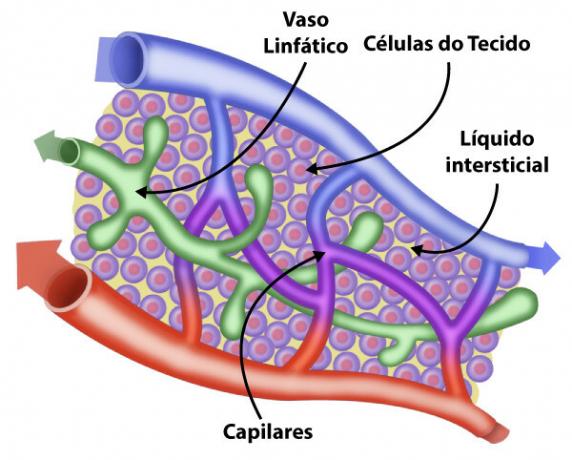Lymph is the name given to a transparent and viscous liquid that circulates in our body through the lymphatic system. This system guarantees the return of important substances to the bloodstream and, moreover, is related to the defense of our body.
The lymph circulates slowly through our body, since the lymphatic system, unlike the cardiovascular system, does not have a organ which helps in pumping this liquid. It is formed from the interstitial fluid and has a composition similar to that of blood plasma, differing in that it has a low concentration of proteins.
Read too: After all, is cholesterol a villain?
Topics of this article
- 1 - Abstract about lymph
- 2 - What is lymph?
- 3 - Difference between lymph and blood
- 4 - How is lymph formed?
- 5 - What are edemas?
- 6 - Lymphatic drainage
summary on lymph
Lymph is a liquid that circulates in the lymphatic system and has a composition that resembles the blood plasma.
Lymph is the name given to the interstitial fluid after it passes into the lymphatic system.
The lymph has a low concentration of proteins.
Failures in the interstitial fluid drainage system cause the accumulation of interstitial fluid between the fabrics and cavities that form our body, a problem known as edema.
A Lymphatic drainage helps in the treatment of edema.
What is lymph?
Lymph it is a fluid that circulates in the lymphatic system and has a composition that resembles blood plasma. It's a liquid transparent and viscous that, unlike the blood, runs slowly through our body because it does not have any structure that guarantees its pumping quickly. For circular lymph, different factors are necessary, such as the contraction of muscles close to the lymphatic vessels, the pulsation of the arteries and the peristalsis visceral and respiratory.
The lymphatic system is formed, in addition to the lymph, by lymphatic vessels and lymphatic organs. It ensures that the liquid present in the interstitial spaces returns to the blood and also acts directly on our Immunity. You lymph nodes, for example, act as filters, and as the lymph passes through it, foreign particles and microorganisms are attacked by cells of immune system. The lymph, in addition to transport immune system cells, ensures the transport of some vitamins fat-soluble andlipidians.
Do not stop now... There's more after the publicity ;)
Difference between lymph and blood
Lymph is a fluid formed from interstitial fluid and has a composition very similar to that of blood plasma. It differs, however, by have less protein. It also stands out for presenting a high concentration of leukocytes, mainly lymphocytes.
How is lymph formed?
As noted, lymph is the name given to the interstitial fluid as it passes into the lymphatic system. This fluid forms when substances like water, oxygen It is nutrients leave the capillary and flow into the interstice. The passage of these substances present in the blood to the existing space between the tissues occurs when the blood pressure is greater than the osmotic pressure.

The interstitial fluid contains essential substances for the metabolism cells, and as the exchange of substances between the cells and the blood takes place, their constitution changes. Part of this fluid is collected by the Cardiovascular system, more precisely by capillaryes venous. This occurs when the interstitial pressure is greater than that existing in the capillary.
A portion of the fluid, however, is not absorbed by the capillaries, being absorbed by the lymphatic system. when the flowiWhen it enters the lymphatic system, it is called lymph. Lymph flows through lymphatic vessels and is discharged into the cardiovascular system through ducts.
See too: Deep vein thrombosis — a problem caused by poor blood circulation
What are edemas?
When the interstitial fluid drainage system fails, it is observed the accumulation of fluiof interstitial between tissues and cavities that form our body, a problem known as edema or swelling. Different factors may be related to the formation of edema, ranging from tissue damage to obstruction of lymphatic vessels, as observed in the case of filariasis.
Lymphatic drainage
Lymphatic drainage is a technique that influencesIt isdirectly into the drainage of the fluifrom the interstitial, helping, for example, in the reduction of edema. Drainage can be done manually or mechanically and, according to the Brazilian Society of Dermatology, aims to increase the volume and velocity of the lymph, to be transported by the vessels and lymphatic ducts, through maneuvers that imitate the physiological pumping.

Still according to the Society, indications for lymphatic drainage are: edematous tissues, compromised return blood circulation, edema in the gestational period It is premenstrual tension, pre and post plastic surgery treatment, post liposuction treatment, cellulitis, scars hypertrophic and keloid scars, relaxation for tense people, among other indications.
It is worth noting that it is fundamental what the lymphatic drainage be done just per capable professionals. Only in this way will the patient achieve a better result and avoid complications that may arise due to inadequate practice.
By Vanessa Sardinha dos Santos
Biology teacher
Do you know what blood capillaries are? Click here and learn about its structure and function, as well as its types. Learn the difference between capillaries and other vessels.
Learn more about the cardiovascular system by understanding the difference between vein, artery and capillary.
What is lymphatic drainage and how is it done.
Expand your knowledge about the cardiovascular system, the system in our body responsible for ensuring blood circulation in the body.
Body Treatments, types of body treatments, lymphatic drainage, acupuncture, auto-hemotherapy.


